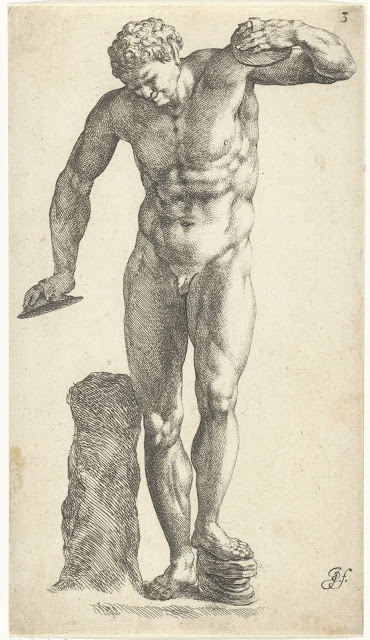 |
| Pietro Cipriani Dancing Faun ca. 1722-24 copy - as bronze statuette Getty Museum, Los Angeles |
 |
| Domenico de Rossi Dancing Faun ca. 1704 etching, engraving Philadelphia Museum of Art |
Fauns were forest creatures with pointed ears and small tails, but otherwise resembled humans – unlike satyrs, who had horns and shaggy legs with hoofs instead of feet. Fauns were known to enter women's dreams and pursue them there, but unlike satyrs, they were seldom represented directly engaged in the sexual chase. Fauns dedicated themselves to more generalized merrymaking.
In Taste and the Antique, Francis Haskell and Nicholas Penny included seven statues of fauns among the most influential and popular works of ancient art on display throughout the period of the Italian artistic dominance of Europe that extended from the 16th up to the 19th century. Of these seven, the Dancing Faun belonging to the Medici was in its day the most famous. Initially displayed at the Villa Medici in Rome, it was referred to as Faun with clappers, Faun with crotale, Medici Faun, and Le Petit Faune. This marble figure carried the reputation of having been restored by Michelangelo (although its modern head and arms were in fact supplied by persons unknown). Most important for its reputation, after removal to Florence, was the fact that it occupied one of the five spots of honor for life-sized marble antique sculptures in that holy-of-holies, the small, eight-sided, deep-red gallery called the Tribuna at the Uffizi. Every one of these five Tribuna sculptures – and every one of their Roman equivalents in the Belvedere at the Vatican – gained supreme international prestige as the undisputed cultural high spots of the Grand Tour.
 |
| Jan de Bisschop Dancing Faun ca. 1663-68 etching Rijksmuseum |
 |
| Jan de Bisschop Dancing Faun ca. 1663-68 etching Rijksmuseum |
 |
| Claude Mellan Dancing Faun 1671 engraving British Museum |
 |
| Baldasare Gabbuggiani Dancing Faun ca. 1752 engraving Philadelphia Museum of Art |
 |
| Giovanni Battista Foggini Dancing Faun ca. 1700 copy - as bronze statuette Getty Museum, Los Angeles |
 |
| Doccia Manufactory, Florence Dancing Faun ca. 1750 copy - as porcelain statuette Metropolitan Museum of Art |
 |
| Anonymous Italian Sculptor Dancing Faun ca. 1750 copy - as ivory statuette Victoria & Albert Museum |
 |
| Anonymous sculptor Dancing Faun before 1846 copy - alabaster statuette birthday gift to Queen Victoria from her mother |
No other faun was reproduced so enthusiastically as the Dancing Faun. But the Faun with Pipes (below) was familiar enough in the 18th century to earn a plaque in blue-and-white porcelain from Josiah Wedgwood in England. The engraving of Faun with Pipes by Karl Audran that follows was made more than a century earlier, when the original marble was in the Borghese Gallery in Rome. In 1807 all the finest pieces of Borghese sculpture were sold to Napoleon and permanently alienated from Rome.
 |
| Josiah Wedgwood Louvre Faun with Pipes in relief ca. 1773 Jasperware medallion Victoria & Albert Museum |
 |
| Karl Audran Louvre Faun with Pipes ca. 1630 engraving Philadelphia Museum of Art |
 |
| Cornelis van Dalen Faun with Pipes 1696 drawing Rijksmuseum |
The Faun in Rosso Antico (below) has for two centuries occupied a gallery named in its honor at the Capitoline Museum in Rome. The reputation of this faun, according to Haskell and Penny, "was partially dependent on the particularly admired variety of close-grained dark-red marble out of which it was made. This marble was seldom found in large pieces and no other full-size figures made of it were then known. Travelers and catalogers of the Capitoline Museum were also enthusiastic about the quality of the carving." The statue's abundance of ornamental detail matched well with the visual preferences of the nineteenth century – a preference for naturalistic elaboration that can make itself felt even today.
 |
| Anonymous photographer Capitoline Faun in Rosso Antico ca. 1880-1904 photograph Rijksmuseum |
The large reclining statue at the bottom of the engraving below is the Barberini Faun, fully restored. The left arm (hanging over the edge of the support) and the left leg are both modern additions and aroused much controversy. The Barberini Faun was consequently "restored" several times, including repeated changes to the base which altered its overall position. The carving of the torso was widely admired. This statue was also sometimes called Bacchus ; Drunken Faun ; Sleeping Faun ; Sleeping Pan ; Satyre Malade.
 |
| Bernard de Montfaucon Barberini Faun (bottom) 1719 engraving Getty Museum, Los Angeles |
 |
| Barberini Faun Roman marble copy of a Hellenistic bronze Glyptothek, Munich |
At present, the Barberini Faun appears as above, more upright than the engraving and with the modern left arm and left foot removed. "It was acquired from the Barberini after protracted negotiations by Crown Prince Ludwig of Bavaria on 29 April 1814. Cardinal Pacca placed a ban on its export which was vigorously supported by Canova, the leading artist in the city (and in Europe), and by one of the leading antiquarians, Carlo Fea; but after the intervention of Ludwig's sister, the Empress of Austria, the ban was lifted on 16 October 1819, and on 6 November the statue set off, pulled by a team of nine mules, for Munich, where it arrived on 6 January 1820. A special room in the Glyptothek had been planned as early as 1815 – it was completed with the Faun in place by July 1827, and was accessible to the general public when the museum opened three years later."